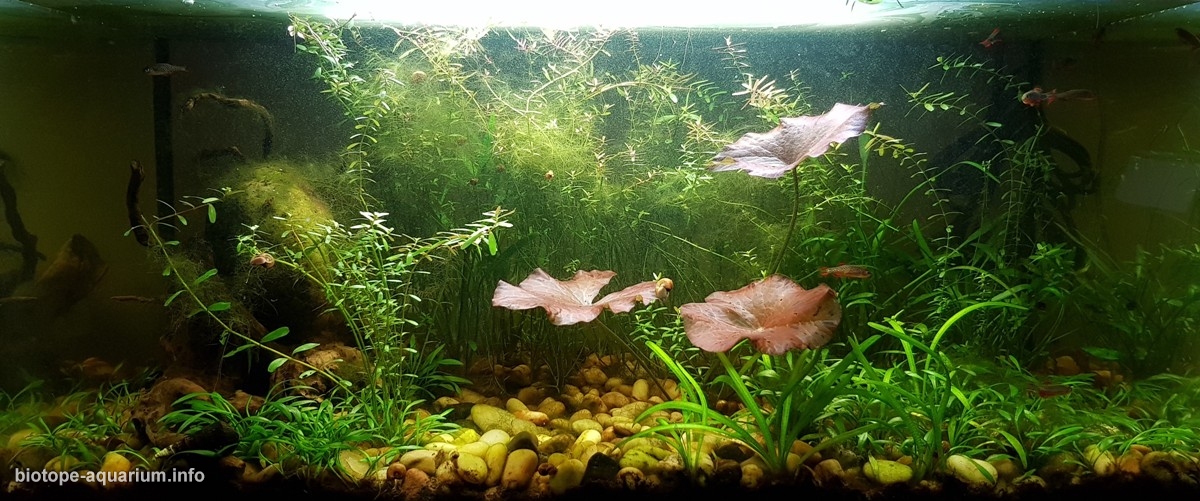Bottom of Inle lake, south of Shan State, Myanmar
106th place in Biotope Aquarium Design Contest 2019
France. Erwan Le Peillet

Volume: 54 L
Dimensions: 60x30x30cm
List of fishes: Danio margaritatus (9 :5 female, 4 male, with regular reproduction)
Atyopsis moluccensis (2 : 2 female)
Melanoides Tuberculata (5 : 5 adults 1 baby)
Planorbis planorbis (around 15 with regular reproduction)
List of plants: Cryptocoryne lucens
Cryptocoryne minima
Nymphaea Lotus Zenkeri
hygrophila polysperma
Description of decorations: Biologique soil like you have in the gardenshop (9 liters)
Turtle gravel 14-16 mm (2,5 liters)
Root spider with a stone on
Description of equipment: Zolux NomiLed 10000K
Water parameters: Temperature : 27°c
PH : 7,8
GH : 8
KH : 9
NO2 and NO3 : 0
NH3 : 0,5
PO4 : 2
Additional info: I make the choice of lowtech to created the most natural eco-system as possible, not for my pleasure but for the confort of animals in.
I try any time to have the more natural process as possible, I never change water, never used chimical product.
I only ad water to compense the evaporation and cut the plants one time each 3 or 4 months, just for saved free place for fish.
INFORMATION ABOUT BIOTOPE
Description of the area surrounding the biotope: The lake take place in a mountainous region, in the middle of Myanmar. The country is in the tropical area of the world but Inle Lake is in altitude and that important because the meteorological conditions aren’t the same as the rest of country, we have tempered conditions around the lake.
The temperature move between 18 / 20°c in winter and 27 / 28°c in summer.
The water is clear the middle, but can came few dark on edge.
The chemical parameters oscillate almost randomly during the year because of the eternal conflict between the fresh and acidic water of the tributaries of the lake and the limestone nature of the rocky plateau. Generaly we have a PH stabilized between 7 and 8, some time he can be evolved, go down near 6,5 and go up to 9
Description of the underwater landscape of the biotope: On the edge of lake, we have root with plants, seaweed and on bottom you can see a dark mud.
In the middle the water is clear like mineral water. We have not surface plant in the middle of lake.
Description of the parameters of the habitat: The lake is fed by poor, sweet and acidic water that has passed through peat bogs while the lake basement is limestone. The lake is therefore dug by the homogeneous dissolution of the Shan plateau by acidic waters. The water from peat bogs is very poor in nutrients, so it is said to be oligotrophic.
List of fishes and invertebrates occurring in the nature biotope: Celestichthys erythromicron
Devario kakhienensis
Esomus danrica
Inlecypris auropurpureus
Microrasbora rubescens
Garra gravelyi
Gymnostomus horai
Labeo rohita
Pethia stoliczkana
Puntius sophore
Puntius cf. sophore
Systomus cf. rubripinnis
Systomus compressiformis
Barbonymus gonionotus
Cyprinus intha
Cyprinus rubrofuscus
Neolissochilus nigrovittatus
Ctenopharyngodon idella
Poropuntius schanicus
Sawbwa resplendens
Anabas testudineus
Channa harcourtbutleri
Channa striata
Trichogaster labiosa
Trichopodus pectoralis
Oreochromis niloticus
Parambassis lala
Parambassis ranga
Glossogobius cf. giuris
Loches:
Lepidocephalichthys berdmorei
Petruichthys brevis
Physoschistura rivulicola
Physoschistura shanensis
List of plants found in the nature biotope: Adiantum edgeworthii
Aldrovanda vesiculosa
Alisma plantago-aquatica
Ammannia baccifera
Arundinella decempedalis
Azolla pinnata
Cephalanthus occidentalis
Ceratophyllum demersum
Cladium mariscus jamaicense
Colocasia esculenta
Cyperus cyperoïdes
Cyperus digitatus
Cyperus sp. « Sha-pya »
Dichrocephala integrifolia
Echinochloa crus-pavonis
Eclipta alba
Elephantopus spicatus
Eryngium foetidum
Eriocaulon quinquangulare
Eichhornia crassipes
Elodea canadensis
Fimbristylis aestivalis
Fimbristylis dichotoma
Gahnia javanica
Hippuris vulgaris
Hedychium coronarium
Hydrilla verticillata
Hydrocotyle
Hygrophila auriculata
Hypericum japonicum
Ipomoea aquatica
Lasia spinosa
Lemna minor
Lemna trisulca
Machaerina sp. « Sha-lone »
Limnophila indica
Ludwigia octovalvis
Ludwigia repens
Lythrum salicaria
Mariscus cyperoides
Monochoria hastata
Monochoria vaginalis
Myriophyllum verticillatum
Najas graminea
Najas tenuis
Nelumbo nucifera
Nitella flexilis
Nymphaea nouchali
Nymphaea pubescens
Nymphoïdes hydrophylla
Nymphoides indica
Ottelia alismoides
Phragmites communis
Phragmites karka
Phyla nodiflora
Plantago major
Polygonum aviculare
Polygonum plebeium
Potamogeton alpinus
Potamogeton crispus
Potamogeton lucens
Potamogeton nodosus
Potamogeton obtusifolius
Potamogeton perfoliatus
Rotala rotundifolia
Ruppia maritima
Sagittaria sagittifolia
Sagittaria trifolia
Salix tetrasperma
Schoenoplectiella supina
Schoenoplectus lacustris
Salvinia cucullata
Spirodela polyrrhiza
Stuckenia pectinata
Thelypteris interrupta
Typha angustifolia
Utricularia aurea et australis
Utricularia gibba
Vallisneria spiralis
Veronica anagallis-aquatica
Xanthium strumarium
Threats to the ecology: The biotope is in permanent evolution with human activity and the fish and plant group evolved with disparition and apparition. The eco-system is in mutation.
Sources of information: I used internet for have pictures, and this differents website, to search alls inftormations I need :
https://naturaliste.ovh/?p=590
https://www.researchgate.net/
https://fr.scribd.com/doc/
https://www.researchgate.net/
https://www.ncbi.nlm.nih.gov/
Finaly I need adapt to my tank and country possibility for all part of my biotope aquarium.
